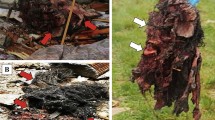Summary
To elucidate the causal mechanism of the main bodily injuries to unbelted drivers and front-seat passengers in motor cars involved in head-on collisions, the results at autopsy were compared to the findings made during the investigation of the cars. The injury pattern depends on the design and the deformation of the car body. The investigation shows, that the trunk of the driver should be kept in the upright position when it is thrown against the steering wheel and the panel in order to minimize injuries. The impact area should be as large as possible to prevent severe injuries. The steering column should not protrude into the passenger compartment. In order to prove the correctness of this theory some experiments with unembalmed cadavers were performed on the impact sled. In other experiments aortic ruptures were produced in cadavers by a blow to the lower part of the anterior chest wall. The intraaortic pressure has been measured in these experiments and the aorta seems to tolerate not more than 1200 mm Hg (dynamic load).
The reconstruction of the “secondary collision” of front-seat passengers indicates, that the best protection against severe injuries can be obtained by maintaining the trunk in the upright position. The impact area (panel) should be as large as possible. The panel (dashboard) should have such a design as to prevent, in case of head-on collision, trauma to the neck of the passenger which would result in an angular acceleration of the head. Experiments with unembalmed cadavers on the impact sled have shown that it is possible to protect the front-seat passenger from injuries in head-on collisions at about 50 km/hr with appropriate panel design.
Zusammenfassung
Zur Klarlegung des Entstehungsmechanismus' der wesentlichsten Körperverletzungen bei nicht durch Gurte geschützten Fahrern und Beifahrern auf dem Frontsitz frontal kollidierender Personenkraftwagen wurden die Befunde bei den Sektionen mit denen an den Unfallfahrzeugen verglichen. Zur Vermeidung schwerer Verletzungen sollte der Rumpf der Fahrzeuginsassen beim Aufprall gegen Lenkung oder Armaturenbrett seine aufrechte Stellung beibehalten und die Aufschlagfläche an der Rumpfvorderseite so groß wie möglich sein. Es muß weiterhin vermieden werden, daß der Kopf beim Aufschlag einer rotatorischen Beschleunigung, eventuell verbunden mit einer Traktion des Halses, ausgesetzt wird. Die Beobachtungen bei Unfallanalysen wurden durch experimentelle Untersuchungen unter Verwendung von nicht einbalsamierten Leichen am Katapultschlitten bestätigt.
Similar content being viewed by others
Literatur
Coermann, R., Dotzauer, G., Lange, W., Voigt, G. E.: The effects of the design of the steering assembly and the instrument panel on injuries (especially aortic rupture) sustained by car drivers in head-on collisions. J. Trauma12, 715–724 (1972)
Dotzauer, G.: Verletzungsfolgen nach Auffahrunfällen — Probleme der inneren Sicherheit aus der Sicht des Mediziners. Taschenbuch: Sicherheit im Straßenverkehr. Stuttgart: Fischer (im Druck)
Lange, W., Voigt, G. E.: Unveröffentlichte Untersuchung
Lundevall, J.: Traumatic rupture of the aorta with special reference to road accidents. Acta path. microbiol. scand.62, 29–33 (1964a)
Lundevall, J.: The mechanism of traumatic rupture of the aorta. Acta path. microbiol. scand.62, 34–46 (1964b)
Voigt, G. E.: Untersuchungen zur Mechanik der Beckenfrakturen und -luxationen. Hefte Unfallheilk.85 (1965)
Voigt, G. E.: Die Biomechanik stumpfer Brustverletzungen besonders von Thorax, Aorta und Herz. Hefte Unfallheilk.96 (1968)
Voigt, G. E.: Personbilens inre säkerhet — hur säker är den ? Läkartidningen66, 993–1007 (1969)
Voigt, G. E.: Huvud-och halsskador vidfrontalkollisioner. Läkartidningen68,1866–1880 (1971)
Voigt, G. E., Lange, W.: Simulation of head-on collisions with unrestrained front seat passengers and different instrument panels. Proc. of Fifteenth Stapp Car Crash Conference, pp. 466–488. New York: Society of Automotive Engineers, Inc. 1971
Voigt, G. E., Löwenhielm, P.: Gliding contusions. Nord. Rdttsmedicinsk Förenings förhandlingar, Lund, 1973
Voigt, G. E., Saldeen, T.: Über den Abriß zahlreicher oder sämtlicher Vv. cerebri sup. mit geringem Subduralhämatom und Hirnstammsläsion. Dtsch. Z. ges. gerichtl. Med.64, 9–20 (1968)
Voigt, G. E., Sköld, G.: Ring fractures at the base of the skull. In press
Voigt, G. E., Wilfert, K.: Mechanisms of injuries to unrestrained drivers in head-on collisions. Proc. of Thirteenth Stapp Car Crash Conference. New York: Society of Automotive Engineers, Inc. 1969
Wilfert, K., Voigt, G. E.: Mechanisms of injuries to unrestrained front seat passengers and their prevention by progressive instrument panel design. Proc. of Fifteenth Stapp Car Crash Conference, pp. 437–465. New York: Society of Automotive Engineers, Inc. 1971
Author information
Authors and Affiliations
Rights and permissions
About this article
Cite this article
Voigt, G.E., Lange, W. & Dotzauer, G. Entstehungsweise der Verletzungen von Fahrern und Beifahrern frontal kollidierender Kraftfahrzeuge. Z Rechtsmed 73, 255–272 (1973). https://doi.org/10.1007/BF01856991
Received:
Issue Date:
DOI: https://doi.org/10.1007/BF01856991




